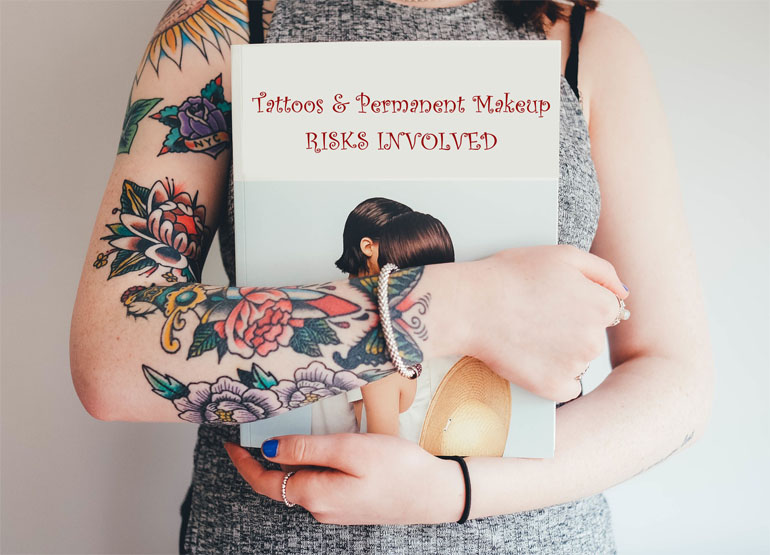Health Pages
Permanent Makeup
Tattoos & Permanent Makeup
FDA considers the inks used in intradermal tattoos, including permanent makeup, to be cosmetics. When FDA identify a safety problem associated with a cosmetic, including a tattoo ink, they investigate and take action, as appropriate, to prevent consumer illness or injury. The pigments used in the inks are color additives, which are subject to premarket approval under the Federal Food, Drug, and Cosmetic Act. However, because of other competing public health priorities and a previous lack of evidence of safety problems specifically associated with these pigments, FDA traditionally has not exercised regulatory authority for color additives on the pigments used in tattoo inks. The actual practice of tattooing is regulated by local jurisdictions.
During 2003 and 2004, FDA became aware of more than 150 reports of adverse reactions in consumers to certain permanent makeup ink shades, and it is possible that the actual number of women affected was greater.
The inks associated with this outbreak were voluntarily recalled by the company that marketed them in 2004. In the spring of 2012, FDA received reports of infections from contaminated inks, resulting in their recall and market withdrawal. In the fall of 2017, a firm voluntarily recalled several colors and sizes of tattoo inks, due to microbial contamination identified by an FDA survey. In addition, concerns raised by the scientific community regarding the pigments used in tattoo inks have prompted FDA to investigate their safe use. FDA continues to evaluate the extent and severity of adverse events associated with tattooing and is conducting research on tattoo inks. As new information is assessed, FDA will consider whether additional actions are necessary to protect public health.
In addition to the reported adverse reactions, areas of concern include tattoo removal, infections that result from tattooing, and the increasing variety of pigments and diluents being used in tattooing. More than fifty different pigments and shades are in use, and the list continues to grow. Although a number of color additives are approved for use in cosmetics, none is approved for injection into the skin. Using an unapproved color additive in a tattoo ink makes the ink adulterated. Many pigments used in tattoo inks are not approved for skin contact at all. Some are industrial grade colors that are suitable for printers' ink or automobile paint.
Nevertheless, many individuals choose to undergo tattooing in its various forms. For some, it is an aesthetic choice or an initiation rite. Some choose permanent makeup as a time saver or because they have physical difficulty applying regular, temporary makeup. For others, tattooing is an adjunct to reconstructive surgery, particularly of the face or breast, to simulate natural pigmentation. People who have lost their eyebrows due to alopecia (a form of hair loss) may choose to have "eyebrows" tattooed on, while people with vitiligo (a lack of pigmentation in areas of the skin) may try tattooing to help camouflage the condition.
Whatever their reason, consumers should be aware of the risks involved in order to make an informed decision.
Risks Involved in Tattooing
Reporting Adverse Reactions
FDA urges consumers and healthcare providers to report adverse reactions from tattoos, permanent makeup, and temporary tattoos, as well as problems with tattoo removal.
USA: Consumers and healthcare providers can report problems to MedWatch, FDA’s problem-reporting program, on the Web or at 1-800-332-1088; or by contacting the nearest FDA consumer complaint coordinator.
CANADA: Contact your nearest Health Canada Product Safety Office or visit your health care provider for treatment and complete an incident report.
INFORMATION DATE: November 29, 2000; updated June 23, 2008, February 1, 2010, and August 22, 2012. This information is current. It is updated only when necessary.
Learn More:
 What You Should Know Before Tattooing and Piercing
What You Should Know Before Tattooing and Piercing
 More About Tattoos & Permanent Makeup
More About Tattoos & Permanent Makeup
 Everything You Should Know About Tattoos
Everything You Should Know About Tattoos
 Tattoos and Piercings: What to Know Beforehand
Tattoos and Piercings: What to Know Beforehand
 Temporary Tattoos & Henna/Mehndi
Temporary Tattoos & Henna/Mehndi
 Tattoo Removal
Tattoo Removal
 Health Risks of Tattooing and Piercing
Health Risks of Tattooing and Piercing
 Transmission of Hepatitis
Transmission of Hepatitis
 Hepatitis
Hepatitis



